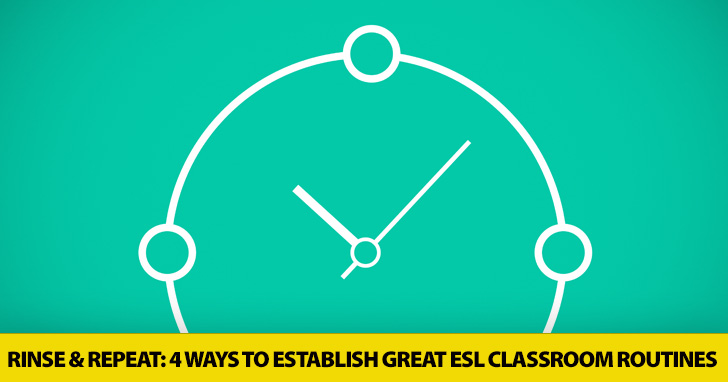The establishing of classroom routines helps speed things along and provides a familiar structure which is both efficient and welcome. Your lessons don’t have to follow a particular template, or even tackle their content in the same order each day, but including fixed, predictable elements can be a real boost. Consider these benefits:
- Reduced Teacher Talking Time (TTT); the students know what to do, which removes the need for you to laboriously explain anything
- The students are engaged in a shared activity; most routines are done by everyone at once, so there is a communal sense of purpose and achievement
- As a result, behavioral problems are less likely, as the students have a clear pattern to follow
- Routines free the teacher to do other things while something mechanistic happens, e.g. to clean and prepare the board while homework is being handed in, or to monitor the other side of the room while a group are working through a set of questions.
It sometimes takes a few days, or even several weeks, to establish routines, but once they’re in place, they add pace and efficiency to your work. One of my favorites is this one: When my ESL students complete the ‘Controlled Practice’ section of the class (gap fills, closed questions, etc) I simply ask, “OK, thank you. On to Free Practice now, please,” and they know just what to do. This relies on the students’ understanding the difference between these two types of practice, benefits from repeated modeling of how to practice language spontaneously and not simply as a result of textbook prompts, and requires a certain level of enthusiasm and zeal from my students. It won’t work in all circumstances, but it’s wonderfully efficient and demonstrates both maturity and clarity of purpose.

Try These 4 Efficient Ways to Establish Great ESL Classroom Routines
-
1
First Lesson Routine
Routine only come into being through repetition, and the best way to ensure that you repeatedly apply a system is by writing it in your lesson plan. Great routines to establish on first meeting a new class might include:
- Warm-up exercises. I recommend both a short speaking exercise and a physical one which includes stretching and deep breathing.
- Applauding good work. This creates a warm and friendly classroom atmosphere, reduces tension and anxiety, and encourages class cohesion and the sense of a journey being shared.
- Quickly coming to silence after an exercise finishes. Every teacher in the world wishes that their students would stop what they’re doing and pay attention just when it’s needed. Routinizing this behavior from the beginning is hugely helpful. Some firmness will be needed, but much can be achieved by gesturing and, in the first few instances, a little patience.
- Handing in / out. A good routine is to simply place the handouts on one student’s desk and say, “One each, please!” The responsibility for distribution is now theirs, and you can do something else. Conversely, if students owe me homework, I simply tap my desk and say something like, “OK, gang, it’s homework time!” After four or five repetitions of this, and realizing that I’m not going to forget to ask for it (because it’s in my lesson plan), my students generally have the pile of homework for me even before I enter the classroom.
- Notebook organization. Early on, establish a routine of writing the date, class, headings for different sections, and using the notebook as an aid to memory. Encourage your students to write on the line, to write down every new word, and to use full sentences so that they understand what they’ve written when they come back to it later.
-
2
Gestures
Gestures are a good way to trigger routines. I have a useful set which I’m recommend to any ESL teacher:
- Pairwork time: two hands interlocking, or appearing to converse together in the manner of hand-puppets.
- Hand-in time: beckoning, tapping the desk.
- Drill in a circle: circling motion with hands or fingers
- Chorus drill / call and respond: hands to my chest, then open to the class, palms up
- Divide into groups: (while giving the instructions), hold up fingers for the number of groups, pointing to where they should gather, then a ‘scattering’ gesture in all directions with both hands.
-
3
Write down the Routine
I use this for my vocabulary practice method, in particular; there are a number of steps, so it’s worth articulating them in a list.
- Write the word
- Say the word and write its IPA
- Figure out its part of speech (noun, verb, etc)
- Use the word in a sentence.
- Look up antonyms and synonyms
- Keep it in mind and use it as soon as you can
Other possibilties include a system for good pairwork:
- Check the target language
- Listen carefully
- Ask lots of questions
- Use full sentences
- Smile!
- Engage your partner
If you can make one or more of these into a mnemonic, like CLAUSE above, so much the better!
-
4
Elicit the Routine
I much prefer for my students to tell me what’s going on than the other way around. When I taught young learners in Thailand, it would have been easy to say, “OK, it’s 3:55, let’s tidy up!” Instead, we established a routine based around the clock - I was teaching them to tell time, anyway - so that all I needed to say was, “Hey, what time is it?” and the response would be, “Three fifty-five! Time to tidy up!”
With older learners, once the pattern of my lessons is clear, efficiency really sets in. We recorded this exchange, from the end of an error-correction exercise, during an upper-intermediate class in Boston last year:
| Teacher: |
And, last one, number ten… Jose? |
| Jose: |
It’s correct except for ‘had’… should be, ‘If I have time, I will help you.’ |
| Teacher: |
Great! Thanks, everyone. Sounds like you’re getting good at these conditionals now. Hey, remind me, how many are there? |
| Students: |
Three / four! |
| Teacher: |
Well, including the Zero Conditional? |
| Students: |
Four! |
| Teacher: |
Awesome! And what should we do next, do you think? |
| Students: |
Free Practice? |
| Teacher: |
You know it! (Gesturing) Pair up! Different pairs, this time. What’s a good question to start? (Open palm gesture, eliciting the question) |
| Pascal: |
‘If you are free tonight, what will you do?’ |
| Teacher: |
I love it! (Big thumbs up) Off you go, gang. |
With very limited classroom instructions and a solid, repeated model, the students moved swiftly from one section of the class to the next, using the target language continuously, and in a mutually supportive, positive atmosphere.
I recommend that you consider which parts of your class work might be ‘automated’ or routinized in this way, to save time and effort, and to give your students a clear structure for their work.


